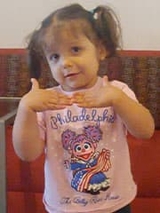Beckwith-Wiedemann Spectrum: Chelsea's Story
Beckwith-Wiedemann Spectrum: Chelsea's Story
A version of the old saying, “If it walks like a duck and talks like a duck, it’s probably a duck” is what Chelsea’s family was feeling.

Chelsea had several features that suggested she had Beckwith-Wiedemann spectrum (BWSp), the most common epigenetic overgrowth and cancer predisposition disorder in children. She had a larger than normal tongue (macroglossia) and her left leg was slightly longer than her right while her right arm was a tiny bit larger than her left one (lateralized overgrowth).
At Chelsea’s 6-month check-up, when her mother, Laura, voiced her concerns, their local pediatrician agreed something was amiss and sent her for an immediate abdominal ultrasound. It came back negative for kidney or liver tumors, the two most frequent tumors found in children with BWSp. “That was a big relief,” says Chelsea’s mother, Laura. “But we still didn’t have a diagnosis.”
Next was an appointment with a geneticist near their home in Arkansas. The clinical exam pointed to a diagnosis of BWSp, but genetic testing of Chelsea’s blood came back negative for BWSp. Still no answer.
Rave Reviews for CHOP’s BWS Clinic
Meanwhile, Laura began her own research and became more convinced Chelsea had BWSp because she had other subtle signs. Chelsea was 9 pounds, 10 ounces at birth, she initially had low glucose levels (which rose to normal on their own before discharge), and she had telltale pits behind her ears.
BWSp was originally called Beckwith-Wiedemann syndrome (BWS), but the name is changing to “spectrum” as researchers learn there is a wide spectrum in the severity of symptoms across the affected population. BWSp is rare, with a prevalence of 1 in 10,340 births, and occurs when there are defects in how a specific region of chromosome 11p15 functions.
More About Beckwith-Wiedemann Syndrome
In addition to wanting an explanation of her daughter’s characteristics, Laura also learned it is important to find out exactly what epigenetic or genetic variant of BWSp Chelsea may have as that guides tumor risk and recurrence risk.
She also joined the BWS Facebook group, where the name Children’s Hospital of Philadelphia (CHOP) kept popping up in parents’ posts. “Everyone was raving about CHOP and how it was the best,” Laura says. She reached out to CHOP’s BWSp Clinic genetic counselor Evan Hathaway, MS LCGC, who explained that genetic testing using a skin biopsy taken from Chelsea’s larger side had a better chance of delivering the definitive diagnosis the family was seeking.
“That’s when we knew that we wanted to go to CHOP,” Laura says. “I wanted the skin biopsy and the genetic test done in the best way at the best place: CHOP. Then COVID hit.”
Finally: Philadelphia, Here We Come
Leery of traveling halfway across the country at the height of the pandemic, Laura kept in touch with Hathaway at CHOP, and Chelsea continued the ongoing screenings of a complete abdominal ultrasound to check her organs for tumors and blood tests to monitor alpha-fetoprotein (AFP), which should steadily decrease over time. A spike in AFP can indicate a liver tumor.
“I kept kidding Evan that when we finally came to town, I wanted to taste the best Philly cheesesteak,” Laura says.
Chelsea, Laura, dad Francisco and older sister Cassie arrived in summer 2021, when Chelsea was 2. During their appointment at the BWS Clinic, she was examined by Jennifer Kalish, MD, PhD, Clinic Director, and had the long-awaited skin biopsy on the upper thigh of her larger leg. “We called it her punch-punch,” Laura says. “It wasn’t fun, but it had to happen.”
They also met with plastic surgeon Jesse Taylor, MD, who determined that Chelsea’s tongue enlargement was mild enough that it didn’t require reduction surgery.
If her symptoms had been more pronounced and called for additional support, she could have met with other members of the BWS Clinic team: orthodontists, speech pathologists, pulmonologists, feeding specialists, oncologists, endocrinologists and orthopedists.
During its stay, the family had time to tour some local sites — the Betsy Ross house was a favorite. True to his word, Hathaway did direct the family to his favorite cheesesteak joint, “and it was fantastic!” Laura says.
Results Bring Peace of Mind

A few weeks after their return to Arkansas, Hathaway called the family with the genetic results: Chelsea had the paternal uniparental isodisomy (pUPD) type of BWSp. With this type, the child receives an extra piece of the father’s chromosome. As a result, the child has some cells with two copies of the father’s chromosome 11p15 region and no copies from the mother’s chromosome. This creates an imbalance in the affected cells, which have an increase in “grow” signals and decrease in “don’t grow” signals, leading to overgrowth. pUPD cases account for about 20% of BWSp diagnoses.
“Now that we know what types she has, we can be sure to follow the proper protocols for screening here at home,” Laura says. “She has about a 15% increase in the chance that she will have childhood cancer, but so far everything looks good. Her dad and I have concerns, of course, but each year, there is less and less of a chance of a tumor.”
These days, Chelsea is in preschool three days a week and is busy playing with Cassie, pretending to ride a horse, swinging on the swing set, dancing like crazy and keeping everyone smiling. “She’s just a hilarious kid,” Laura says. “She’s so funny, she keeps us laughing all the time.
They’ll return to CHOP’s BWS Clinic once a year to make sure everything is on track.
“If we hadn’t come to CHOP, I would have always wondered what the people at CHOP would have said. The staff there are the most knowledgeable in the country about this rare condition, and I trust them completely,” Laura says. “Chelsea didn’t have the most dramatic case of BWS because her symptoms were so mild. CHOP solved a puzzle for us.”